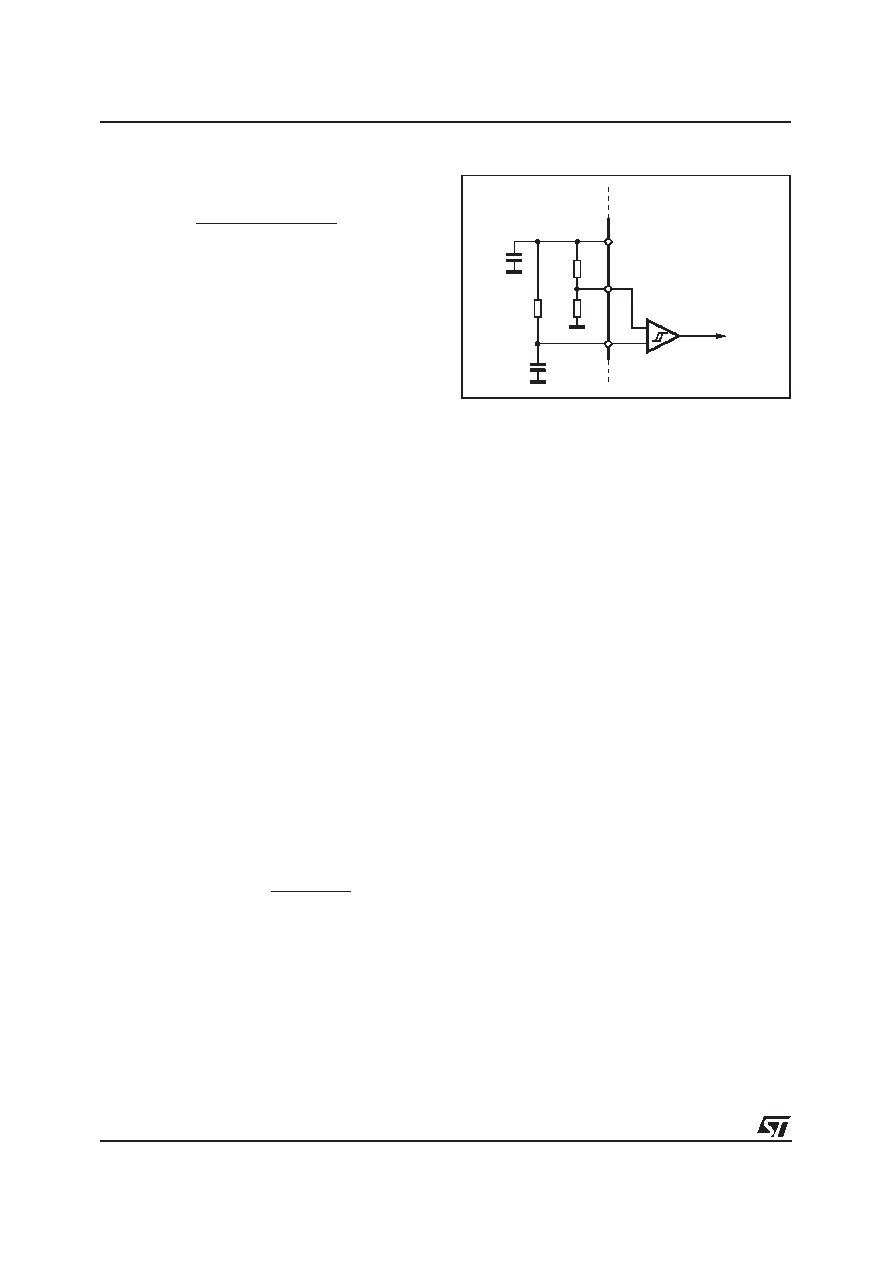- 您現(xiàn)在的位置:買賣IC網(wǎng) > PDF目錄43899 > L4990 (STMICROELECTRONICS) 1.5 A SWITCHING REGULATOR, 1000 kHz SWITCHING FREQ-MAX, PDIP16 PDF資料下載
參數(shù)資料
| 型號: | L4990 |
| 廠商: | STMICROELECTRONICS |
| 元件分類: | 穩(wěn)壓器 |
| 英文描述: | 1.5 A SWITCHING REGULATOR, 1000 kHz SWITCHING FREQ-MAX, PDIP16 |
| 封裝: | DIP-16 |
| 文件頁數(shù): | 2/24頁 |
| 文件大小: | 322K |
| 代理商: | L4990 |

The frequency can be established with the aid of
fig. 13 diagrams or considering the approximate
relationship:
fosc
1
CT
(0.693 RT + KT)
(1)
where KT is defined as:
KT =
90, V15
= VREF
160 V15
= GND/OPEN
(2)
and is linked to the duration of the falling edge of
the sawtooth:
Td
30 10-9 +KT CT (3)
Td is also the duration of the sync pulses deliv-
ered at pin 1 and defines the upper extreme of
the duty cycle range, Dx (see pin 15 for Dx defini-
tion and calculation).
In case V15 is connected to VREF, however, the
switching freque ncy of the system will be as
high as half fosc.
If the IC is to be synchronized to an external oscil-
lator, RT and CT should be selected for a fosc
lower than the master frequency in any condition
(typically, 10-20% ), depending on the tolerance
of RT and CT itself.
Pin 3. DC (Duty Cycle Control). By biasing this
pin with a voltage between 1 and 3 V it is possible
to set the maximum duty cycle between 0 and the
upper extreme Dx (see pin 15).
If Dmax is the desired maximum duty cycle, the
voltage V3 to be applied to pin 3 is:
V3 =5 - 2
(2-Dmax)
(4)
Dmax is determined by internal comparison be-
tween V3 and the oscillator ramp (see fig. 22),
thus in case the device is synchronized to an ex-
ternal frequency fext (and therefore the oscillator
amplitude is reduced), (4) changes into:
V3
= 5 4
exp
Dmax
RT
CT fext
(5)
A voltage below 1V will inhibit the driver output
stage. This could be used for a not-latched device
disable, for example in case of overvoltage pro-
tection (see application ideas).
If no limitation on the maximum duty cycle is re-
quired (i.e. DMAX =DX), the pin has to be left float-
ing. An internal pull-up holds the voltage above
3V. Should the pin pick up noise (e.g. during ESD
tests), it can be connected to VREF through a
4.7k
resistor.
Pin 4. VREF (Reference Voltage). An internal
generator furnishes an accurate voltage reference
(5V
±1.5%) that can be used to supply an external
circuit (consider some ten mA).
A small film capacitor (1
F typ.), connected be-
tween this pin and SGND, is recommended to
preventswitching noise from affecting the reference.
Before device turn-on, this pin has a sink current ca-
pability of 0.5mA.
Pin 5. VFB (Error Amplifier Inverting Input). The
feedback signal is applied to this pin and is com-
pared to the E/A internal reference (2.5V). The
E/A output generates the control voltage which
fixes the duty cycle.
The E/A features high gain-bandwidth product,
which allows to broaden the bandwidth of the
overall control loop, high slew-rate and current
capability, which improves its large signal behav-
ior. Usually the compensation network, which sta-
bilizes the overall control loop, is connected be-
tween this pin and COMP (pin 6).
Pin 6. COMP (Error Amplifier Output). Usually,
this pin is used for frequency compensation and
the relevant network is connected between this
pin and VFB (pin 5). Compensation networks to-
wards ground are not possible since the L4990
E/A is a voltage mode amplifier (low output im-
pedance). See application ideas for some exam-
ple of compensation techniques.
Pin 7. SS (Soft-Start). At device start-up, a ca-
pacitor (Css) connected between this pin and
SGND (pin 12) is charged by an internal current
generator, ISSC, up to about 7V. During this
ramp, the E/A output is clamped by the voltage
across Css itself and allowed to rise linearly, start-
ing from zero, up to the steady-state value im-
posed by the control loop. The maximum time in-
terval during which the E/A is clamped, referred to
as soft-start time, is approximately:
+
-
R2
R1
RT
CT
D97IN501A
VREF
RCT
DC
TO PWM LOGIC
4
3
2
Figure 22. Duty cycle control.
L4990 - L4990A
10/24
相關(guān)PDF資料 |
PDF描述 |
|---|---|
| L4990D | 1.5 A SWITCHING REGULATOR, 1000 kHz SWITCHING FREQ-MAX, PDSO16 |
| L5970AD | 1.8 A SWITCHING REGULATOR, 500 kHz SWITCHING FREQ-MAX, PDSO8 |
| L5972D013TR | 3 A SWITCHING REGULATOR, 280 kHz SWITCHING FREQ-MAX, PDSO8 |
| L5972D | 3 A SWITCHING REGULATOR, 280 kHz SWITCHING FREQ-MAX, PDSO8 |
| L5973AD | 2.3 A SWITCHING REGULATOR, PDSO8 |
相關(guān)代理商/技術(shù)參數(shù) |
參數(shù)描述 |
|---|---|
| L4990A | 制造商:STMICROELECTRONICS 制造商全稱:STMicroelectronics 功能描述:PRIMARY CONTROLLER |
| L4990AD | 制造商:STMICROELECTRONICS 制造商全稱:STMicroelectronics 功能描述:PRIMARY CONTROLLER |
| L4990D | 制造商:STMICROELECTRONICS 制造商全稱:STMicroelectronics 功能描述:PRIMARY CONTROLLER |
| L4991 | 功能描述:TEST COIL FOR REED SWITCH, 1PC RoHS:是 類別:開關(guān) >> 配件 系列:- 標(biāo)準(zhǔn)包裝:100 系列:- 其它名稱:886.0007886.0007-ND |
| L4992 | 制造商:STMicroelectronics 功能描述: 制造商:STMicroelectronics 功能描述:VOLT SUPERVISOR CNTRLR 5.1V/3.3V 32TQFP - Trays |
發(fā)布緊急采購,3分鐘左右您將得到回復(fù)。